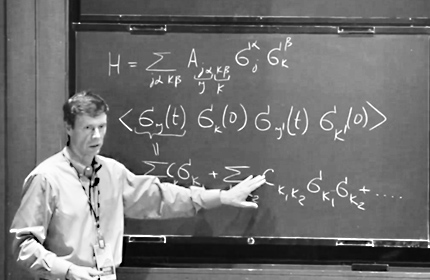

Harlow will discuss some new ideas on how to think about the emergence of the black hole interior for an old black hole. Quantum Error Correction and the Page Curve Thus, an experimentalist carrying out generic, low-rank quantum operations on the radiation cannot measure or modify the interior state of the black hole. Specifically, the interior density matrix is correctable against the action of quantum operations on the radiation which (i) do not have prior access to details of the microstate, and (ii) do not have large, negative coherent information with respect to the maximally mixed state on the radiation, with a lower bound controlled by the black hole entropy. Balasubramanian will show how the new picture can be consistent because of the complex structure of the encoding of the interior in the Hawking radiation. This seems surprising because conventional reasoning would say that instead there should be separate physical degrees of freedom in the black hole interior and in the distant radiation. Recent discoveries suggest that the interior of an old evaporating black hole is dual to the Hawking radiation emitted from it. It from Qubit continues to be a vibrant community whose members are eager to make use of every opportunity to learn from each other, and the annual meeting is always a highlight of the calendar. As usual, the time between the talks was filled with intense scientific discussion. In addition, a poster session on the first afternoon gave the IFQ postdocs the opportunity to present their latest research. Finally, PI Juan Maldacena (Institute for Advanced Study) reviewed recent work on the transition in the spectrum of string theory between highly excited string states and small black holes. PI Alexei Kitaev (California Institute of Technology) then explained a new method for computing out-of-time-order correlators (OTOCs), which are used to diagnose chaos in many-body quantum systems. On the second day of the meeting, PI Brian Swingle (Brandeis University) developed a hydrodynamic theory to describe the universal “ramp” behavior in the spectral form factor of a chaotic quantum system.

PI Daniel Harlow (Massachusetts Institute of Technology) explained how to understand the recent calculations of the Page curve for evaporating black holes in terms of the picture of holography as a quantum error-correcting code. Crystal Noel (Duke University) described her group’s experiments realizing measurement-induced phase transitions in trapped ions. Former IFQ postdoc Nima Lashkari (now faculty at Purdue University) then explained how RG flows can be thought of as quantum error-correcting codes, in which the low-energy operators are the protected, or logical, observables, with a specific focus on the continuous MERA RG scheme. The talks kicked off with PI VIjay Balasubramanian (University of Pennsylvania) describing the analysis of circuit complexity in the sense of Nielsen for SYK models, highlighting in particular how chaotic versus integrable dynamics are reflected in the time-dependence of complexity. The meeting at the Simons Foundation featured seven speakers: five IFQ PIs, one former IFQ postdoc and one experimentalist. It was immediately preceded by a three-day IFQ workshop at the Institute for Advanced Study, providing a full week of exciting scientific interaction. Nonetheless, with around 80 in-person attendees and 30 or so people following the talks remotely, the meeting was lively and productive. Due to the ongoing pandemic and associated travel restrictions, only about half of the collaboration’s principal investigators (PIs) and postdocs were able to attend the event in person. The It from Qubit (IFQ) Simons Collaboration held its sixth annual meeting on December 9–10, 2021. Vijay Balasubramanian, University of Pennsylvania The 2021 annual meeting will be devoted to recent developments at the interface of fundamental physics and quantum information theory, spanning topics such as chaos and thermalization in many-body systems and their realization in quantum gravity wormholes and their information-theoretic implications calculable lower-dimensional models of quantum gravity the entanglement structure of semi-classical states in quantum gravity complexity in field theory and gravity the black-hole information puzzle and theoretical and experimental aspects of quantum simulation and measurement-induced phase transitions.


 0 kommentar(er)
0 kommentar(er)
